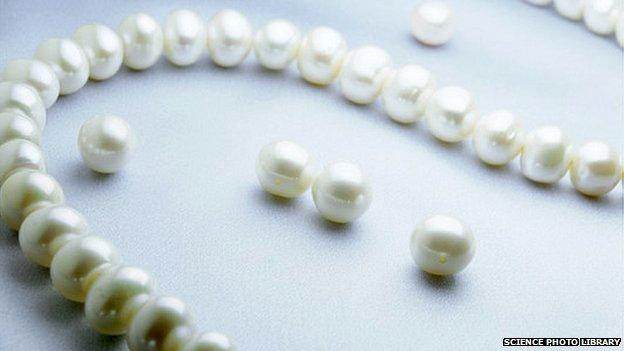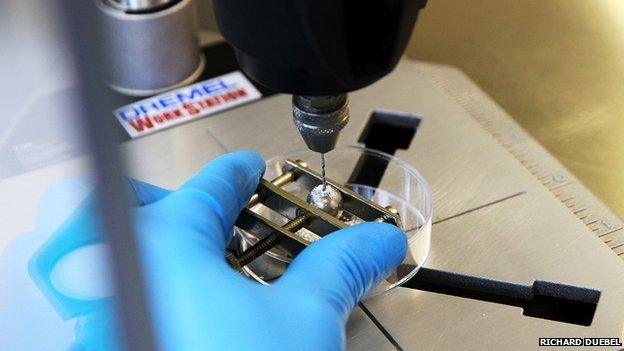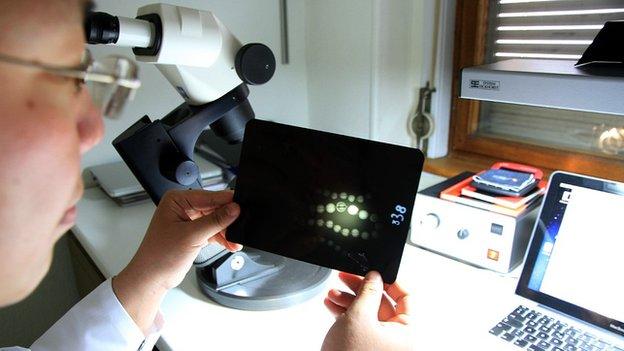Cutting edge science used to ID natural pearls
- Published

Pearl dealers are turning to cutting edge science to help them distinguish between cultured pearls and the natural kind. Natural pearls continue to fetch high prices, but methods for culturing them have become so sophisticated that it is increasingly difficult to tell between them.
As Ali Safar takes a pearl out of the X-ray machine, he looks carefully at it before passing the large luminescent bead to an analyst who scrutinises it through a microscope.
The Directorate of Precious Metals and Gemstone Testing in Bahrain can produce crystal clear images but as Ali Safar says, detecting a cultured pearl is not straightforward.
"Today we see cultured pearls that have virtually the same structure as a natural pearl," he explains. "The means of producing cultured pearls have become ever more sophisticated so as to mimic the real thing."
Whereas in the past Bahraini pearl merchants such as the Al Mahmouds would have been able to spot a natural pearl just by looking at it, today's market is more complex.
Making the distinction is important in Bahrain, where it is forbidden to trade in cultured pearls.
But it is also a distinction that is challenging the Swiss Gemmological Institute (SSEF) and in particular its director Michael Krzemnicki who is called on by the major auction houses to provide certificates stating whether a pearl is natural or cultured along with additional information about shape, size, colour and hue.
At the institute's laboratory headquarters in Basel all pearls undergo three weeks of increasing complex examination, inspected by a team of half a dozen experts using specially designed equipment to delve ever more deeply into the formation mechanism of each pearl that arrives.

Traditionally, Bahraini pearl merchants have been able to spot a natural pearl just by looking at it
"The history of a piece of jewellery has always been of considerable interest," Michael Krzemnicki says.
"In the case of pearls there are numerous elements that are significant when it comes to provenance. Technology is able to identify definitively the type of shell from which a natural pearl originates, whether a fresh water mollusc or a salt water wild oyster. But our latest testing methodology can reveal a lot more."
Using methods such as UV-visible photo-spectrometry and micro-Raman spectroscopy, some of the more straightforward of the stringent tests now being applied to the dozens of strands of pearls, sets of earrings, bracelets, brooches and rings arriving at the institute each week. This provides sufficient information to satisfy most clients.
Laurent Cartier, a project manager at the SSEF, says: "We can see whether a pearl has a nucleus indicating that a human-induced, artificial irritant introduced into the shell to stimulate the growth of a cultured pearl."
But he points our that even a battery of enhanced visual examinations can be misled by some cultured pearls such as the Keshi.
"The Keshi pearl has no nucleus but is nonetheless induced by human intervention," he explains.

It is now possible to obtain DNA from pearls - providing more information about their origins
"We now have a special 3D tomography imaging machine that can enter the pearl layer-by-layer and so gets a far more distinct view."
The institute is called on to certify old pearls that have been traded for over a hundred years and the research contributes to providing or confirming specific historical background.
By the end of next year, says Michael Krzemnicki, a more precise instrument will be in use.
"We have developed a new approach to radiography using an instrument made in collaboration with a Swiss academic research institution. It gives us enhanced, more detailed structures through scatter effect X-ray," he explains.
With huge differences in value, attempts to pass off cultured pearls as natural pearls are not uncommon.
This has forced international auction houses, who sell directly to investors with possibly only a limited knowledge of pearls, to provide one or more authenticity certificates from independent scientific bodies.
But certification of colour, shape, size and hue is no longer enough for those who have a focus on the precise area where a pearl developed and its age.
This has has led to the development of new methods that can pinpoint the type of oyster, a geographic location and a time scale. Joana Meyer who works as a researcher for the Department of Environmental System Science at the Swiss Federal Institute of Technology (ETH) in Zurich has been able to genetically fingerprint a pearl.
"For the first time we've been able to obtain DNA from a pearl and test it," she states.
"We've developed a non-destructive technique - enlarging the already existing drill hole to obtain very fine particles - pearl powder - and then testing it."
Some 10mg of drilled sample powder is sufficient to identify the oyster species.

X-rays can shed some light in certain cases
"DNA is well preserved in pearls even if they were harvested many years earlier and stored in a safe at normal temperatures over many years," she adds.
This breakthrough makes it possible to identify whether a pearl originates in the Arabian Gulf or Australia. An important scientific discovery and one that also has financial implications for buyers and investors.
"We can determine if it is a Basra pearl as they are known in the Gulf," says Joana.
DNA testing has augmented what can be known about a pearl and its formation, but at present this additional information is not routinely made known by the SSEF. As Michael Krzemnicki says, consideration needs to be given to the way this is presented in a report.
"Whatever our laboratory does in terms of science we always have to think carefully how we offer this as a service to clients," he told BBC News.
He goes on to explain that the organisation's expertise and development of new technology will allow further identification - and that this may result in adjustments to prices for certain pearls.
"As DNA fingerprinting becomes easier, it may be possible to say that a pearl comes not only from the Arabian Gulf but from a particular place in that area," he explains. "We have to consider what this will mean to the final customer."